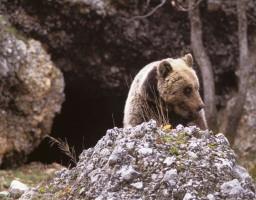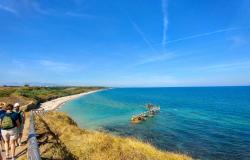A female specimen of central Italy's endangered bear population has been found dead in the country's biggest national park, forest services said Friday.
Investigators are working to establish the precise cause of death, but Abruzzo National Park chiefs said an initial examination of the body seemed to suggest the Marsican brown bear was poisoned.
''If this suspicion proves correct, we're talking about another unacceptable act of defiance against the park,'' said park president Giuseppe Rossi.
The six-year-old bear's death is a further blow to the park's drive to bring the Marsican bear back from the brink of extinction after three animals were poisoned in autumn last year.
A subspecies of the brown bear, the Marsican (Ursus arctos marsicanus) lives exclusively in the central Italian Apennine mountains.
''It is unacceptable to kill a bear belonging to a species of which only between 40 and 45 examples still survive in the entire Apennine range,'' the Italian section of the Worldwide Fund for Nature (WWF) said on Friday.
The Abruzzo branch of animal protection society ENPA called on the freshly appointed minister of environment, Stefania Prestigiacomo, to ''act immediately'' and to ''urgently nominate a ministerial commission to investigate the efficacy of guardianship and controls in the park''.
In October three bears were found to have been poisoned with a powerful fungicide, prompting the Italian section of the WWF to put a 10,000-euro bounty on the heads of the culprits and calls from the Green Party for ''harsh prison terms''.
One of the three bears, 'Bernardo', was an international celebrity, often pictured ambling into inhabited areas where villagers publicly made a fuss of him.
But although Marsican bears are one of the most people-friendly in existence, other villagers were unhappy with incursions by Bernardo and his kin, claiming they were a menace.
The disappearance of high-mountain fodder and smallholdings has been one of the reasons why the bears have begun roaming further downhill, causing friction with humans.
The parks' conservation project aims to boost bear numbers to around 100.
Forest rangers have planted 20 different species of fruit tree and bush in the 1,600-square-kilometre area the Marsican bear roams around to ensure the animals will eventually have enough food the year round.
The authorities are also campaigning to raise local people's awareness of the need to respect the bears' environment and have been targeting hunters.
One of the smaller brown bears, male specimens usually weigh 95-130 kilos and are 1.8-1.9 metres tall when standing on their hind legs.
NORTHERN BEAR TROUBLES.
Last month an Italian project to reintroduce the Italian brown bear (Ursus arctos) into the Alpine regions of northern Italy also hit a setback when one of the animals was shot after wandering into Switzerland.
Swiss authorities said the bear, named JJ3, had become ''problematic'' because he showed no fear of humans and was approaching inhabited areas in his search for food.
His more famous brother, Bruno, sparked a diplomatic row in June 2006 when he too was shot dead, in that case after he ambled across the Italian border through Switzerland into Bavaria in Germany.
Both bears were born in the Adamello-Brenta national park in Trentino, where authorities imported ten animals from Slovenia as part of the ''Life Ursus'' conservation project to repopulate the area.








